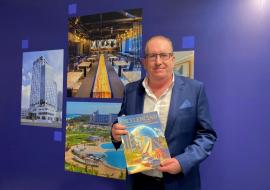Marta Blanco, Director General of Spain’s Tourism Institute

During one of the sessions of MITT 2015 we talked to Marta Blanco, Director General of Turespaña, who exclusively aired with Caribbean News Digital her opinion on the development of Spanish tourism in 2014 and the way this country has gone beyond the two barriers of international tourism: transportation, by means of airlift, and administrative matters, related to visa issues.
What Spanish regions reported tourism growth in 2014?
In global terms, 2014 was a record year in Spain: 65 million international tourists, 63 billion of euros spent. As for the Russian market, over the past 10 years the number of Russian tourists has been multiplied by 8, we’ve had a two-digit increase, and in 2014 global figures went 17 percent down in Spain. Still, there are two regions where the number of Russian tourists has gone up: Madrid and Comunitat Valenciana.
Beyond the number of tourists, it’s very important for us to speak in terms of value, instead of volume. In this sense, the Russian tourists that visited Spain in 2014 entailed more value that back in 2013. That’s something to be highlighted, since the Russian tourist that visits our country has increased the average daily expense, expense per tourist and average stay in Spain.
Is the real estate investment related to long-staying Russian tourism still growing?
It’s growing, but we’re talking about 1.400,000 Russians in 2014 and a million and half in 2013. Residential tourism is still a very small percentage of that million and half that came in 2013 or the 2014 result. The trend is actually positive. The Spanish law passed on this matter has contributed and encouraged the increase of residential Russian tourists in Spain.
Could the work developed by the Spanish embassy in Russia in order to streamline the visa issuing process, by multiplying the number of official related to this matter, be a benchmark for the country to keep on growing?
There are two barriers to be surpassed in terms of international tourism: transportation barriers, related to airlift, and administrative matters, related to visa issues. As for the administrative ones, Spain is closely working with the Ministry of Foreign Affairs and Cooperation that, by means of its embassies and consulates, is responsible for the visa issuing process and precisely works to make this process more flexible and improve the conditions for international tourists to be given their visas.
In this sense, the Russian embassy has collaborated with us to stop having the visa issue as a barrier for Russian tourists.
Spanish gastronomy is one of the main wellness sources for tourists visiting the country. Is there any statistic on the opinion of Russian tourists regarding Spanish cuisine and how valuable is that when it comes to choosing where to travel?
We have recently carried out an advertising campaign in Russia and we realized that Russian tourists highly appreciate two things in Spain: quality, a very important element, and diversity. Within the diversity, they feel that we can offer several tourism products and our cuisine is precisely one of them, and that’s an attribute and resource taken into account by Russian tourists when it comes to traveling overseas. The gastronomy clearly contributes to improve the perception of Russian tourists on Spain.
What actions would you recommend to be developed by some Caribbean countries that are trying to attract the Russian market?
We have the tremendous responsibility of being leaders, because we’re the third country that receives the largest number of tourists, the second one in terms of tourism expenses, and we have to hold our ground. That’s the reason why we have to be competitive, increase the competitiveness in our travel industry if we want to hold that leadership. In order to raise the competitiveness in the travel industry we bet on a diversification strategy with other destinations, mostly based on quality standards.
Does the Spanish government have any possibility to support Iberia or any other airline so they can have their hub in Spain and stand as a bridge between America and the European countries that are being operated by Air France and KLM?
First of all, the 2014 figures in Madrid and the airport were substantially better than 2013. Therefore, the trend has changed its course and that’s good news. Just as I mentioned before, we cope with two types of barriers. We were already talking about the visa.
With regard to airlift barriers, we’re certainly working with Iberia and every national or international airline in an effort to give this matter a boost. We closely collaborate with the Ministry of the Economy by means of AENA (Spanish Airports and Air Navigation) so as to look for opportunities in outbound markets and airlines in outbound markets that are studying the possibility of opening new routes.
We have a promotion strategy of Spain as a tourism destination to open those new routes in collaboration with the Ministry of the Economy and the Ministry of Foreign Affairs and Cooperation.
For example, a very important meeting is being held this week in China with the participation of all airlines, destinations, airports, which are looking for what we do here, in MITT: matching offer and demand, airlines looking for opportunities and destinations offering opportunities. Turespaña is there with AENA.
Do you have any plan or campaign for Iberian-America to be an important outbound market for Spain?
The Latin American and Caribbean countries are essential for us. We’re talking about outstanding markets in terms of tourism. Let’s take, for instance, the Brazilian market. Brazil has recently entered the list of the top ten countries with the highest tourism expense when they travel abroad. That’s an example in this area of the world.
Therefore, these emerging countries are priority. In Turespaña we’re dedicating budgetary resources and human resources to foster the promotion of Spain as a tourism destination in these countries. The potential is huge and we’re looking at it.














